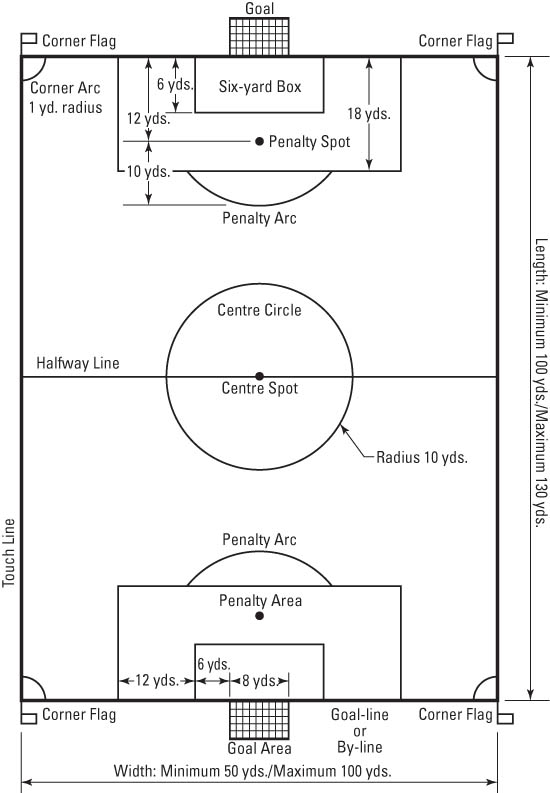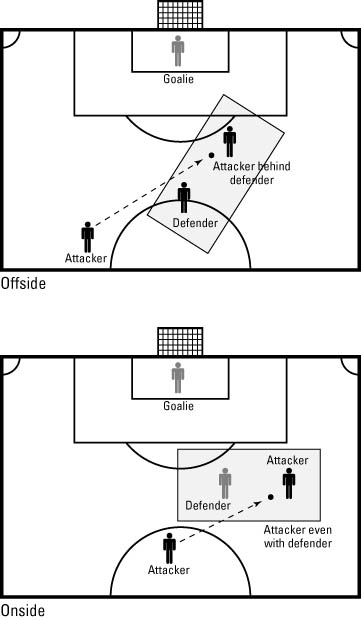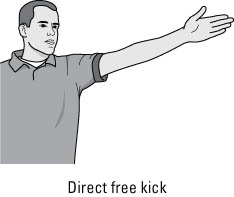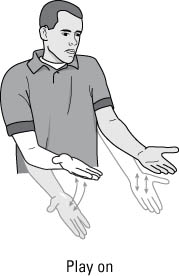>
The Football Pitch, or Field of Play
If you’re going to understand football as those in the UK see it, you need to find your way around the pitch the game is played on (or playing field in American English). This diagram is here to help.

>
>
>
Explaining the Offside Law: Law 11
The offside law (Law 11) is the most argued-over law wherever in the world the game of football is played, even though it’s pretty simple. Here’s how it works.
A player is caught offside if he’s nearer to the opponents’ goal than both the ball and the second-last opponent when his team-mate plays the ball. In other words, a player can’t receive the ball from a team-mate unless there are at least two players either level with him or between him and the goal.
It is not an offence in itself to be offside. A player is only penalised for being offside if he is deemed to be involved in active play. So a player can only be called offside if he is:
In the opposition’s half.
Interfering with play (that is, he’s part of the attacking move).
Interfering with an opponent (that is, he’s preventing the opponent from defending against the attacking move).
Gaining any advantage by being in that position.
A player cannot be offside from a goal kick, throw in or corner.

>
>
>
Refereeing Signals in Football
The referee controls a game of football, implementing the laws of the game (whether the sport is played in the United States or the United Kingdom). Perhaps no other team sport leaves such a wide margin for individual interpretation of the rules as football does.
Knowing what a referee has signalled and understanding why he has done so are essential to your understanding of the game (though it won’t stop you yelling at him). These are some of the most important hand signals you see referees use.




>
>
>
Stretching for Football Warmup
Different players in the UK have their own personal stretching routines, depending on their physical make-up. A qualified fitness instructor can plan a bespoke programme for you, but there’s no need to worry if you can’t do that because performing the following stretches should be more than satisfactory.
Quadriceps: Stand by a wall. Bend one leg up behind you using one hand to steady yourself against the wall and the other to keep your leg in place by holding onto your foot. To make the stretch gently pull your foot upwards.
Hamstrings and lower calf: Sit on the ground. With one foot extended out in front of you, extend your arm towards your foot. While sitting bolt upright, keeping your back straight, run your arm as far down your leg as you can.
Groin: Sit on the ground. Place the soles of both of your feet together, so your knees are bent out to the side of your body. Then, while keeping your back straight, try to press both of your knees as close to the ground as possible. Push your chest out while you do this.
Lower back: Lie down on your back. Pull one or both of your knees towards your chest while keeping your shoulders and head on the ground.
Calf muscle and Achilles tendon: Stand by a wall. Place one leg forward, bending it at the knee. Push forward against the wall, keeping your back foot flat on the ground. The forward leg stretches your Achilles tendon and the back leg stretches the calf muscle. Switch legs and repeat the stretch.
Hip flexor: Get on one knee. Bend your rear leg so the knee is near the ground while extending your front leg and your hands towards your toes.
>
>
dummies
Source:http://www.dummies.com/how-to/content/football-for-dummies-cheat-sheet-uk-edition.html
No comments:
Post a Comment